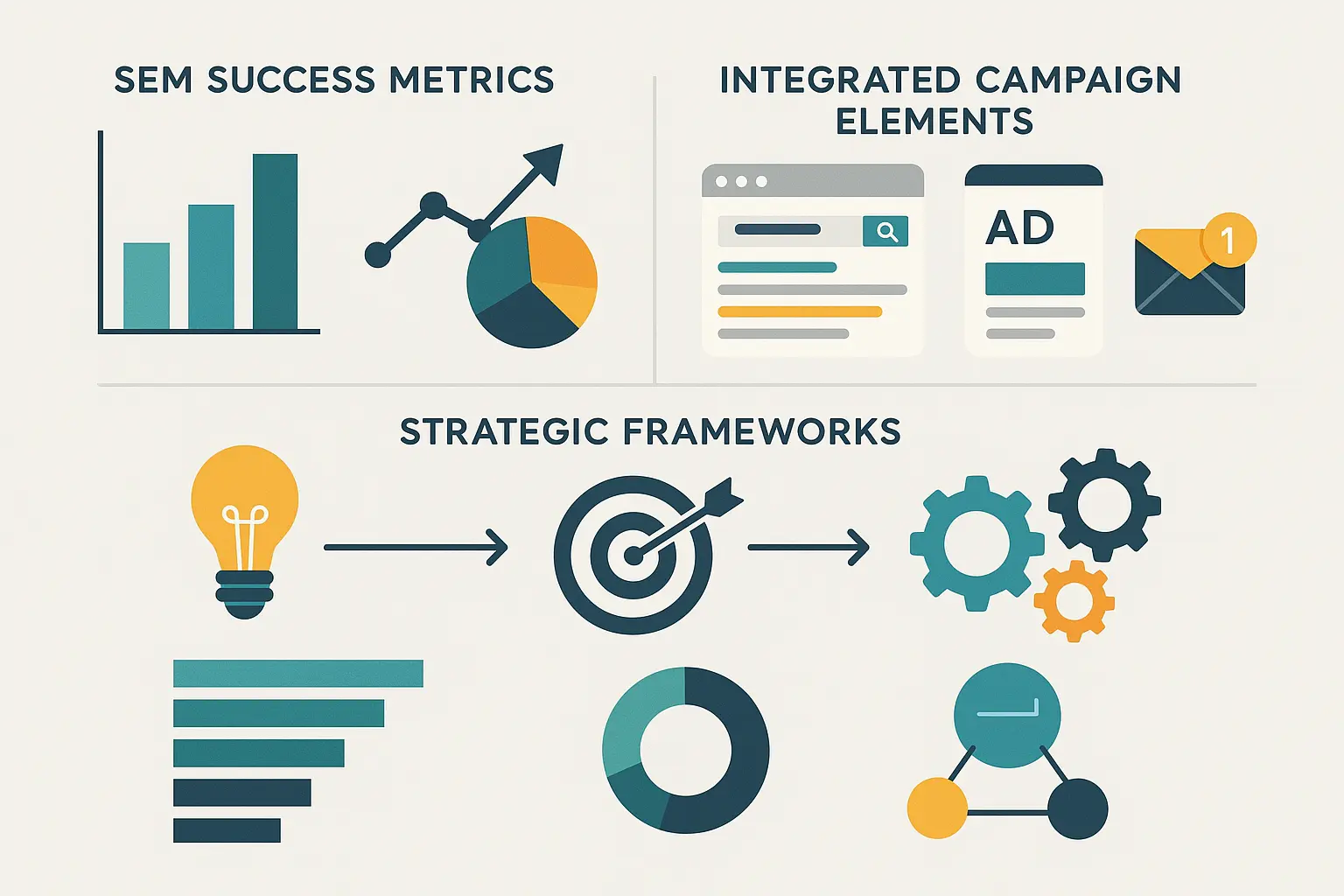Table of Contents
-
Why Most SEM Case Studies Miss the Mark
-
Building Your Case Study Foundation the Right Way
-
SEO Case Studies That Show Real Growth
-
Making Paid and Organic Work Together
-
Campaign Execution That Gets Results
-
Advanced Tracking That Actually Makes Sense
-
Industry-Specific Strategies That Work
-
Developing Campaigns That Scale
-
Final Thoughts
TL;DR
-
Most case studies fail because they don’t establish proper baselines or document the complete customer journey
-
Technical SEO improvements must be measured alongside content and link-building efforts for accurate attribution
-
Paid and organic search work best when treated as complementary channels, not separate campaigns
-
Real-time optimization requires automated systems and clear performance thresholds
-
Cross-platform attribution modeling reveals the true customer journey better than single-touch attribution
-
Industry-specific approaches dramatically outperform generic SEM strategies
-
Campaign architecture should prioritize integration across channels from day one
Why Most SEM Case Studies Miss the Mark
Look, I’ve been through hundreds of SEM case studies over the years, and honestly? Most of them are complete garbage. They’ll throw up some fancy graph showing traffic went from here to there and pat themselves on the back. But here’s the thing – they’re missing all the stuff that actually matters.
The real problem? Nobody bothers documenting where they started. I can’t tell you how many times I’ve seen a case study bragging about “300% traffic increase!” without mentioning they went from 10 visitors to 30. Or worse, they don’t track what those visitors actually did once they got there.
You want to know what separates the pros from the wannabes when creating a search engine marketing case study? It’s the boring stuff nobody wants to talk about – baseline metrics, competitor analysis, and actually understanding what your market looked like before you touched anything.
I learned this lesson the hard way when a client fired me after what I thought was a wildly successful campaign. Sure, I’d cranked their organic traffic up 150%, but their revenue had actually tanked because I’d attracted completely the wrong kind of visitors. Turns out, the traffic I’d replaced was way more valuable than the traffic I’d brought in. Oops.
According to Smart Insights Search Engine Statistics, Google processes over 8.5 billion searches every day, which equals 6.3 million searches per minute. With that much noise, you better believe your competition is fierce, and flying blind is a recipe for disaster.
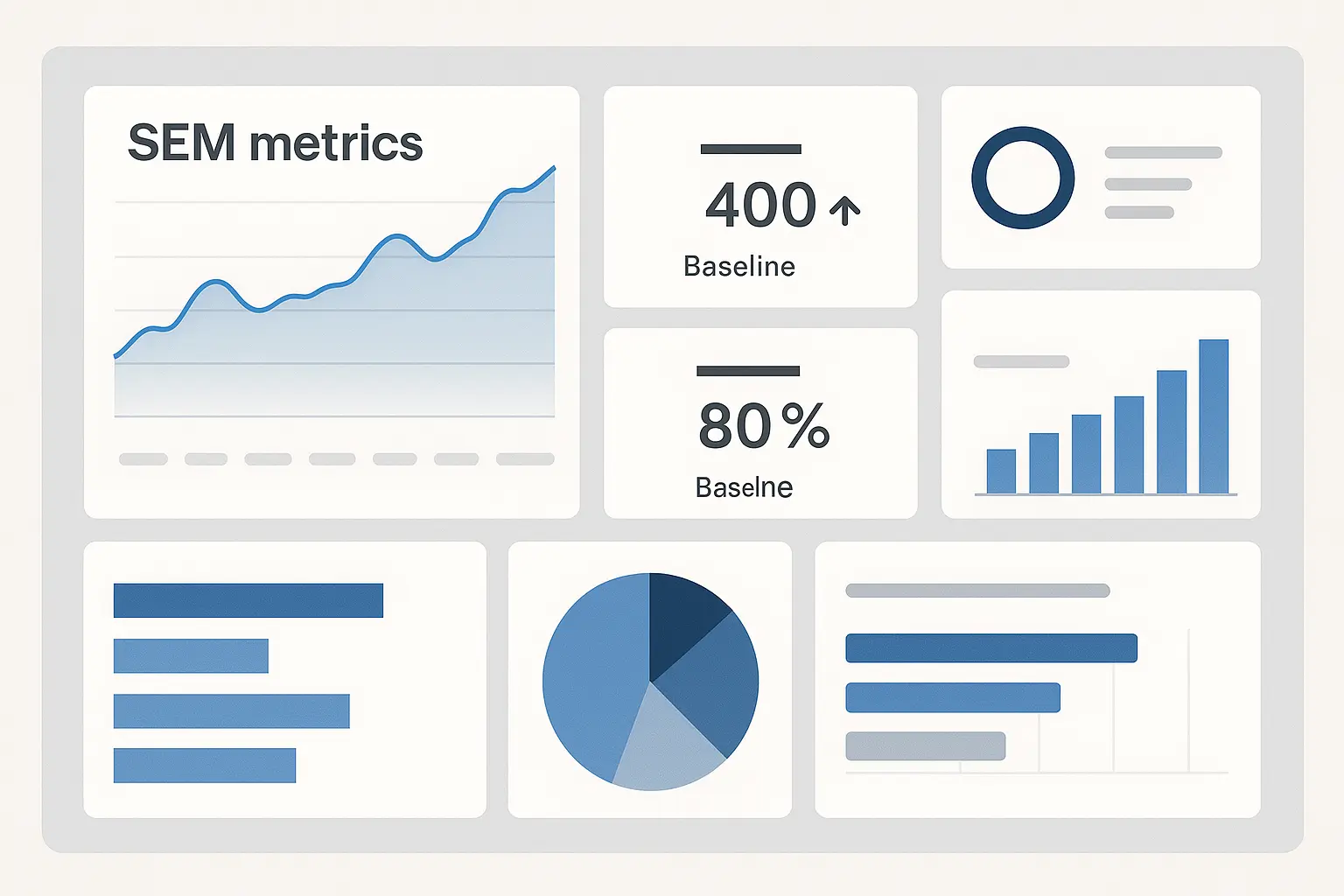
Getting Your Pre-Campaign Analysis Right
Before I launch anything these days, I spend what probably feels like forever documenting everything. My clients sometimes get antsy (“Can’t we just start running ads?”), but trust me – this groundwork pays off big time when you’re trying to prove your results later.
First thing I do is dig into whatever they’ve already tried. What keywords were they ranking for? Which ads had they run before? What happened with those campaigns – did they work, did they bomb spectacularly, and most importantly, why?
Then I get nosy about their competition. Who’s dominating their space? What’s their strategy looking like? How are they positioning themselves? I’ll spend hours going through competitor ads and landing pages, taking screenshots, making notes. It’s like detective work, but for marketing nerds.
Here’s what I wish someone had told me when I started: document EVERYTHING about your starting point. Not just the pretty metrics that make you look good, but the messy stuff too. What’s your actual conversion rate when you dig into the data? How much does it really cost to get a customer? What’s a customer actually worth to you over their lifetime?
I once worked with a SaaS company that thought they were killing it because their cost-per-click was super low. Sounds great, right? Wrong. Those cheap clicks weren’t converting worth a damn, and their actual customer acquisition cost was through the roof. If we hadn’t documented this mess upfront, we never would’ve caught it.
|
Pre-Campaign Documentation Checklist |
Status |
Notes |
|---|---|---|
|
Historical organic search performance |
☐ |
Include rankings, traffic, and conversion data |
|
Previous paid campaign analysis |
☐ |
Document what worked and what didn’t |
|
Competitor landscape mapping |
☐ |
Identify top 5-10 competitors and their strategies |
|
Baseline conversion rates by source |
☐ |
Track organic, paid, direct, and referral |
|
Average order value calculations |
☐ |
Break down by traffic source and campaign type |
|
Customer acquisition cost baselines |
☐ |
Include all costs: ads, tools, and labor |
|
Lifetime value measurements |
☐ |
Segment by acquisition channel |
|
Success criteria definition |
☐ |
Set specific, measurable KPI targets |
Documenting Strategy and Structure
This is where most people get lazy, and it drives me absolutely crazy. They’ll throw a bunch of tactics at the wall without explaining WHY they made those specific choices. Future you (and anyone else reading your case study) needs to understand the thinking behind your decisions.
When I’m doing keyword research, I document not just what keywords I picked, but my entire thought process. Why did I prioritize these over those? What tools did I use? How did I balance search volume against competition? What made me think these keywords would actually drive business results instead of just vanity traffic?
Same thing with ad copy testing. I don’t just say “we tested some headlines.” I explain how many variations we ran simultaneously, what specific elements we tested, how long we let tests run before making calls, and what criteria we used to pick winners. The devil’s in the details, and those details are what make case studies actually useful instead of just pretty to look at.
For one B2B client, I created this three-tier keyword strategy that worked incredibly well. Tier 1 was 50 high-intent commercial keywords – stuff like “project management software” with decent search volume and clear buying intent. Tier 2 was 200 educational keywords targeting people who knew they had a problem but weren’t sure about solutions yet. Tier 3 was 500+ long-tail keywords for early-stage research.
We allocated 60% of budget to Tier 1, 30% to Tier 2, and 10% to Tier 3. Six months later, qualified leads were up 40%. But here’s the kicker – most of those Tier 1 conversions had actually touched Tier 2 or 3 content first. Without documenting the whole strategy and tracking the customer journey, we never would’ve seen that connection.
Results Analysis That Actually Matters
Here’s where things get really messy, and where most case studies completely fall apart. They’ll show you some impressive percentage increases without any context about whether those results actually mean anything for the business.
Real results analysis means tracking the entire customer journey, not just that last click before someone converts. I use multiple attribution models because each one tells a different part of the story. First-click attribution shows me what’s driving initial awareness. Last-click reveals what’s actually closing deals. Time-decay helps me understand all the messy stuff that happens in between.
But here’s what really matters – did your campaign actually drive NEW business, or did you just shuffle existing demand around? I can’t tell you how many campaigns I’ve seen that looked wildly successful until someone realized they’d just cannibalized other marketing channels.
Statistical significance is your friend here, even though it’s about as exciting as watching paint dry. You need enough data to know whether your results are real or just random luck playing tricks on you. I’ve seen too many people make expensive decisions based on a week’s worth of data that turned out to be meaningless.
The best part about thorough results analysis? It shows you exactly what to do differently next time. I always include a “what I’d change if I could do it over” section in my case studies because, let’s be honest, nothing ever goes perfectly the first time around.

Building Your Case Study Foundation the Right Way
The biggest mistake I see people make is treating case studies like an afterthought. They run a campaign, get some results, then try to piece together a coherent story afterward. That’s completely backwards and usually results in a mess.
The best case studies are planned from day one. You build documentation systems right into your campaign process so you’re capturing insights as they happen, not trying to remember them months later when everything’s a blur.
The search landscape keeps evolving too, which makes this even more important. Backlinko’s SEO Strategy Guide reports that over 58.5% of searches now end without a click – people are getting their answers right in the search results. This means your case studies need to track brand awareness and engagement metrics, not just clicks and conversions.
SEO Case Studies That Show Real Growth
SEO case studies are particularly tricky because organic success depends on so many moving parts working together. You can’t just fix your title tags and call it a day – you need technical improvements, killer content, and authority building all firing on all cylinders simultaneously.
The real challenge is proving what actually moved the needle. If you’re fixing site speed AND publishing new content AND building links all at the same time, how do you know which effort deserves credit for those ranking improvements? Spoiler alert: they probably all contributed, which makes clean attribution nearly impossible.
When developing an seo case study, it’s crucial to document not just the tactics you used, but the strategic reasoning behind each decision. The most valuable seo case studies show how different optimization efforts compound to create sustainable organic growth that actually lasts.
Research from Smart Insights shows that organic and paid search combined make up 80% of all trackable website visits, with the current split being 53% organic and 27% paid. With organic being the bigger piece of the pie, comprehensive SEO case studies are absolutely crucial for understanding what’s really driving your results.
Technical SEO Audit and Implementation
Technical SEO is the foundation that everything else builds on, but it’s also the most boring part of any case study. Nobody gets excited reading about crawl errors and page speed optimization, but ignore this stuff at your own peril.
I start every SEO project with a comprehensive site audit that covers the basics: How fast are pages actually loading on both desktop and mobile? Can search engines crawl all the important stuff without hitting roadblocks? Are there indexation issues hiding in plain sight that could be tanking your visibility?
Structured data markup and schema optimization deserve special attention because they can really make your search results pop. But documenting the actual impact is tricky – did that featured snippet come from your schema implementation, or was it just better content structure? You need to isolate variables as much as possible, which isn’t always realistic.
Core Web Vitals have become huge ranking factors, so I always track Largest Contentful Paint, First Input Delay, and Cumulative Layout Shift scores before and after optimization. The challenge is connecting improvements in these technical metrics to actual ranking changes, especially when you’re making other optimizations at the same time.
I worked with an e-commerce site that was loading in 8+ seconds on mobile – absolutely brutal for user experience. After optimizing images, implementing lazy loading, and cleaning up their bloated code, we got load times down to under 3 seconds. Organic traffic jumped 35% over the next three months. Was it all due to speed improvements? Probably not, but it definitely played a major role.
The challenge with technical seo case studies is proving direct causation between technical fixes and ranking increases. Other factors like content updates and link building often happen simultaneously, making it tough to isolate impact. That’s why baseline documentation becomes so critical.
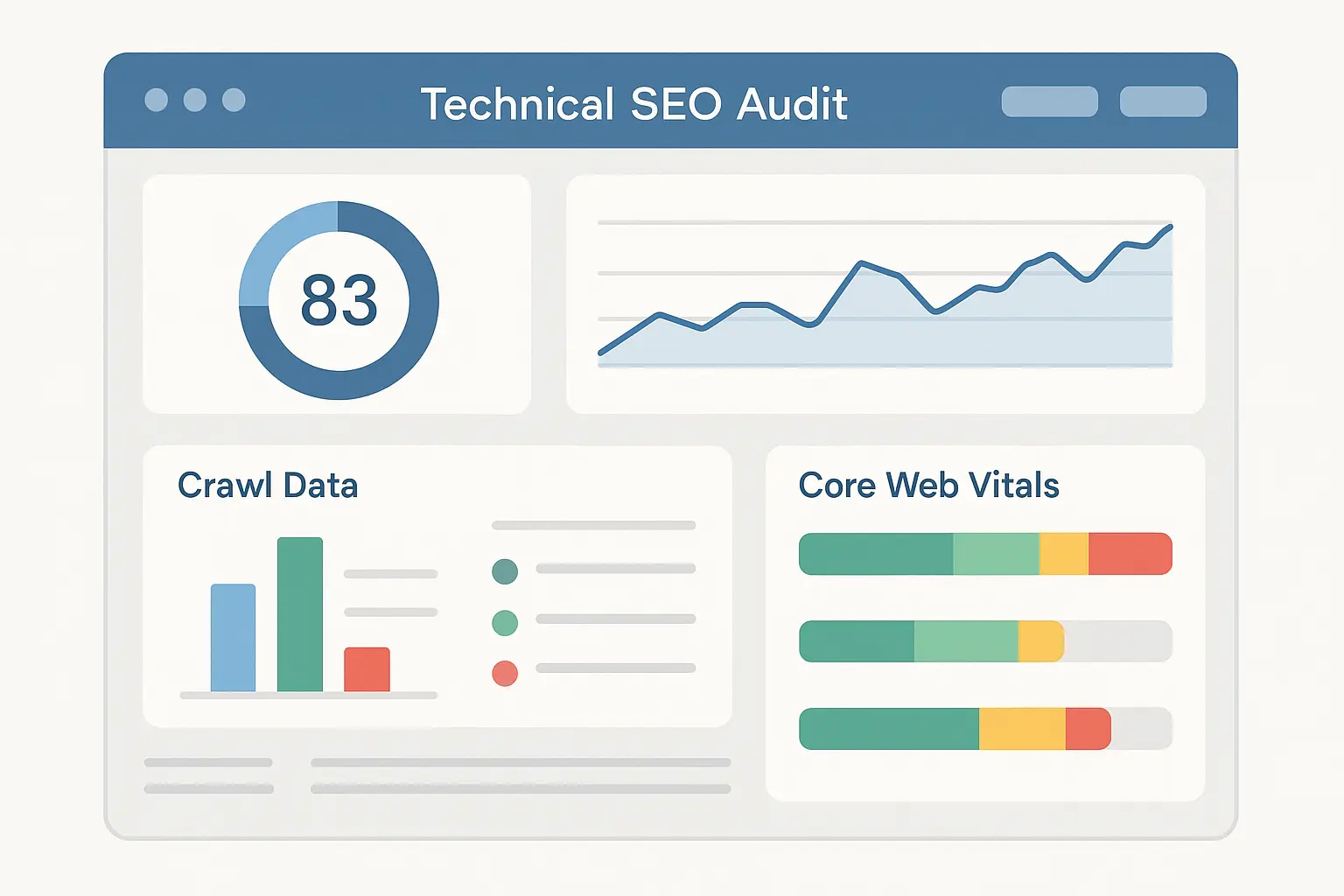
Content Strategy and Optimization Results
Content strategy case studies need to go way beyond “we published more blog posts and traffic went up.” What kind of traffic are you actually attracting? Are those visitors converting into customers? Are you reaching the right audience for your business goals, or just driving vanity metrics?
I always start with a thorough content gap analysis – what are competitors covering that we’re not? Where is there clear search demand that nobody’s adequately addressing? How do we prioritize content creation based on actual business impact potential rather than just what seems interesting?
Tracking keyword ranking improvements is important, but don’t stop there. Featured snippets often drive way more traffic than traditional #1 rankings these days. I document which content pieces achieve featured snippets, what format they used (paragraphs, lists, tables), and how this actually impacted click-through rates and conversions.
The most compelling seo case studies show clear connections between specific content pieces and real business outcomes. When documenting content strategy results, focus on how individual pieces contributed to overall organic growth rather than treating each piece in isolation.
I measure organic traffic growth at the page level, not just site-wide totals. Which pieces of content are driving the most valuable traffic? How are different content types performing – blog posts versus resource pages versus product descriptions? This granular analysis helps you understand what content strategies actually work versus what just looks good on paper.
For that SaaS client I mentioned earlier, we created a comprehensive “Complete Guide to Project Management Software” that ranked #2 for the main keyword within six months. It drove 15,000 monthly organic visitors with a 12% conversion rate to free trials – way higher than our average.
The key was structuring the content with clear sections, actionable tips, and strategic internal linking to product pages. But without documenting the entire strategy and measuring performance at this level of detail, we never would’ve been able to replicate that success with other topics.
Successful seo case studies often reveal that content performance varies dramatically across different topics and formats, making detailed documentation essential for actually replicating your wins.
Link Building and Authority Development
Link building is probably the hardest part of SEO to document effectively because so much depends on relationship building and outreach – stuff that’s really tough to systematize and replicate consistently.
I document everything about my outreach process in painful detail: how I identify link prospects, how I personalize outreach messages, what my follow-up sequence looks like, and what response rates I actually achieve at each stage. It’s tedious work, but this data becomes invaluable for improving future campaigns.
Quality matters way more than quantity when it comes to links, which makes case study documentation more complex. One high -authority link from a relevant site might have more ranking impact than dozens of low-quality directory submissions. I track the domain authority and topical relevance of linking sites, not just total link counts.
The real value in link building case studies comes from measuring correlation between link acquisition and ranking improvements. When I acquire high-quality links to specific pages, how do those pages’ rankings actually change? What’s the typical timeline between getting the link and seeing results in search?
For a local service business, I secured a single link from the city’s chamber of commerce website – took weeks of relationship building and follow-up. Within two weeks of the link going live, their “plumber [city name]” ranking jumped from page 2 to position #3. That one strategic link was worth more than 20 random directory submissions combined.
The most effective seo case studies demonstrate how link building efforts work together with technical improvements and content optimization to create sustainable ranking improvements across entire websites, not just individual pages.

Making Paid and Organic Work Together
This is where I see the biggest missed opportunities in search marketing. Most people treat paid and organic like they’re competing against each other instead of working together to completely dominate search results and guide customers through your funnel.
When you coordinate these efforts properly, magic happens. You get more real estate on search results pages. You can use paid campaigns to test keywords before investing heavily in organic optimization. You can protect your organic rankings with paid coverage during those inevitable algorithm updates that mess everything up.
Understanding the relationship between sem and ppc strategies becomes crucial when you’re developing integrated campaigns that maximize your visibility across all search touchpoints.
Keyword Synergy and Coverage Analysis
Effective keyword synergy starts with mapping the overlap between your paid and organic campaigns. Where are you already ranking organically for terms you’re also bidding on? This isn’t necessarily wasteful spending – studies actually show that paid and organic listings can work together to increase your overall click-through rates.
I analyze impression share data to find coverage gaps in search visibility. Are there high-value keywords where you’re missing out on impressions because you’re not bidding aggressively enough? Are there terms where your organic rankings have dropped and paid coverage could fill that gap while you work on improvements?
The goal isn’t eliminating all overlap between paid and organic – it’s optimizing the combination for maximum business impact. Sometimes paying for keywords you already rank for organically makes perfect sense. Sometimes it’s a waste of money. The key is making these decisions based on actual performance data rather than gut feelings.
For a B2B software client, we were ranking #1 organically for “project management software” but also bidding on it pretty aggressively. The data showed that having both listings actually increased our total click share from 15% to 28%. The combined approach was definitely worth the investment, even though it seemed redundant on the surface.
|
Keyword Performance Analysis |
Organic Position |
Paid Position |
Combined CTR |
Action Required |
|---|---|---|---|---|
|
“project management software” |
#3 |
#2 |
18.5% |
Increase organic content depth |
|
“team collaboration tools” |
#1 |
#1 |
22.1% |
Reduce paid bids by 20% |
|
“workflow automation” |
#8 |
#3 |
12.3% |
Boost organic with backlinks |
|
“task management app” |
Not ranking |
#4 |
8.7% |
Create targeted content |
|
“remote work software” |
#2 |
Not bidding |
15.2% |
Add paid coverage |
Budget Optimization Across Channels
Budget optimization across paid and organic channels requires understanding the true cost and value of each approach. This goes way beyond simple cost-per-click calculations – you need to factor in the time and resources invested in organic optimization, the lifetime value of customers from different channels, and those compound effects of authority building that are tough to measure.
Here’s what most people get wrong: they think organic search is “free.” It’s not. Sure, you’re not paying per click, but you’re investing serious money in content creation, technical optimization, and link building. Make sure you’re accounting for all these costs when you’re comparing channel performance.
I set up dynamic budget allocation based on seasonal performance patterns that most businesses can predict. Your budget allocation should reflect these patterns, shifting more resources to paid campaigns during peak seasons when organic rankings alone might not be enough to capture all available demand.
Develop attribution models that actually give credit to both organic and paid touchpoints in the customer journey. A customer might discover your brand through organic search, research your products through paid ads, and finally convert through a direct visit weeks later. Single-touch attribution models miss this complexity entirely and lead to bad decisions.
When planning a comprehensive search engine marketing campaign, budget allocation decisions should consider how paid and organic work together rather than treating them as competing investments fighting for the same pot of money.
According to Entrepreneurs HQ, businesses earn $2 for every dollar spent on Google Ads, but this metric only tells part of the story when organic search contributes to the customer journey before that final paid click conversion.
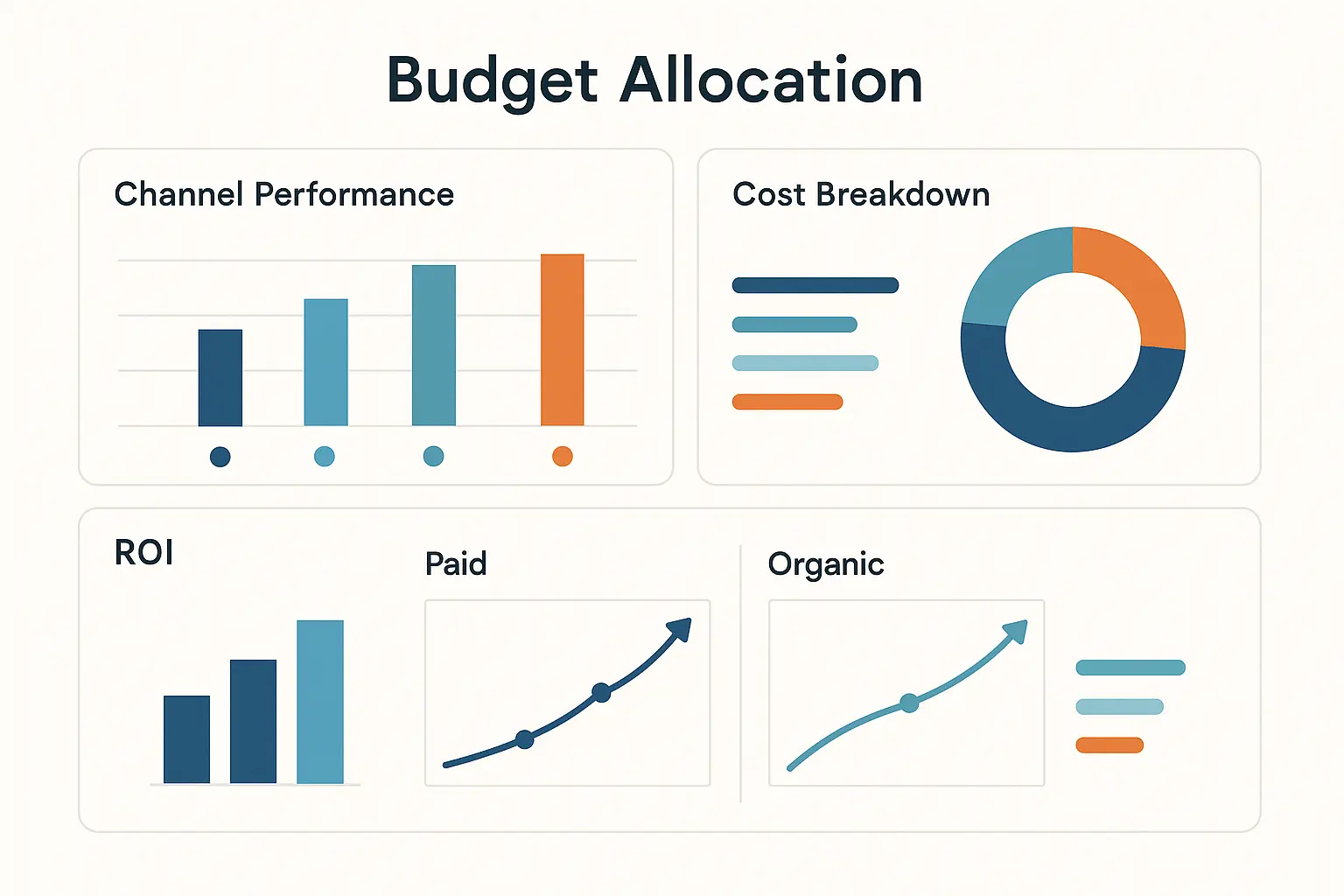
Campaign Execution That Gets Results
Campaign execution is where your brilliant strategy either comes to life or dies a horrible death. You can have the most perfect plan in the world, but if you can’t execute it effectively and optimize based on real-time performance data, you’re not going to hit your goals.
The difference between good and great campaign execution comes down to having solid systems and processes in place. You need automated monitoring that actually alerts you when things go sideways. You need optimization frameworks that help you make smart decisions quickly. You need testing protocols that ensure you’re always getting better instead of just spinning your wheels.
Real-Time Performance Monitoring
Real-time performance monitoring has become absolutely essential as search marketing gets more competitive and consumer behavior becomes less predictable. You can’t just check your campaigns once a week and hope everything’s still working properly.
I set up automated bidding strategies with custom conversion goals that actually align with business objectives. Don’t just optimize for clicks or even generic conversions – optimize for the specific actions that actually drive revenue for your particular business. This might be purchases, lead form submissions, phone calls, or app downloads, depending on what you’re trying to accomplish.
Performance alerts for significant metric changes need to trigger immediate attention. What counts as “significant” depends on your campaign volume and typical performance variations. For high-volume campaigns, a 20% change in conversion rate might warrant investigation. For smaller campaigns, you might need larger thresholds to avoid false alarms that waste your time.
I create dynamic budget reallocation rules based on ROI thresholds that actually make sense. When campaigns are performing above target, they should automatically get additional budget. When performance drops below acceptable levels, budget should shift to better-performing campaigns or pause entirely until you can figure out what’s wrong.
Machine learning models for predictive performance optimization use your historical data to anticipate seasonal fluctuations, identify optimal bidding opportunities, and predict which creative variations are likely to perform best with different audience segments.
The recent Google antitrust ruling requiring Google to share portions of its search index with qualified competitors means marketers will need to adapt their monitoring systems to track performance across multiple search engines rather than focusing solely on Google.
Creative Testing and Optimization Frameworks
Creative testing separates successful campaigns from mediocre ones, but most people approach it completely wrong. They’ll run a couple of ad variations for a few days and declare a winner based on limited data. That’s not testing – that’s just guessing with extra steps.
I establish statistical significance thresholds for all creative tests before I even start. What confidence level do I need to make decisions? How much data do I need to collect before calling a test conclusive? These decisions get made upfront, not after I see results that might tempt me to call things early.
Multivariate testing for landing page optimization can work really well, but don’t overcomplicate things when you’re starting out. Test one element at a time until you have enough traffic volume to support more complex testing scenarios. Headlines, call-to-action buttons, and form fields often have the biggest impact on conversion rates.
Creative rotation strategies prevent ad fatigue, which is a real problem that kills performance over time. Even your best-performing ads will eventually see declining results as audiences become familiar with them. I build rotation schedules that introduce fresh creative regularly while keeping top performers in the mix.
Heat mapping and user session recordings reveal exactly where users are clicking, where they’re dropping off, and what elements are causing confusion or friction in your conversion funnel. This behavioral data drives user experience optimization that actually moves the needle instead of just making things look prettier.
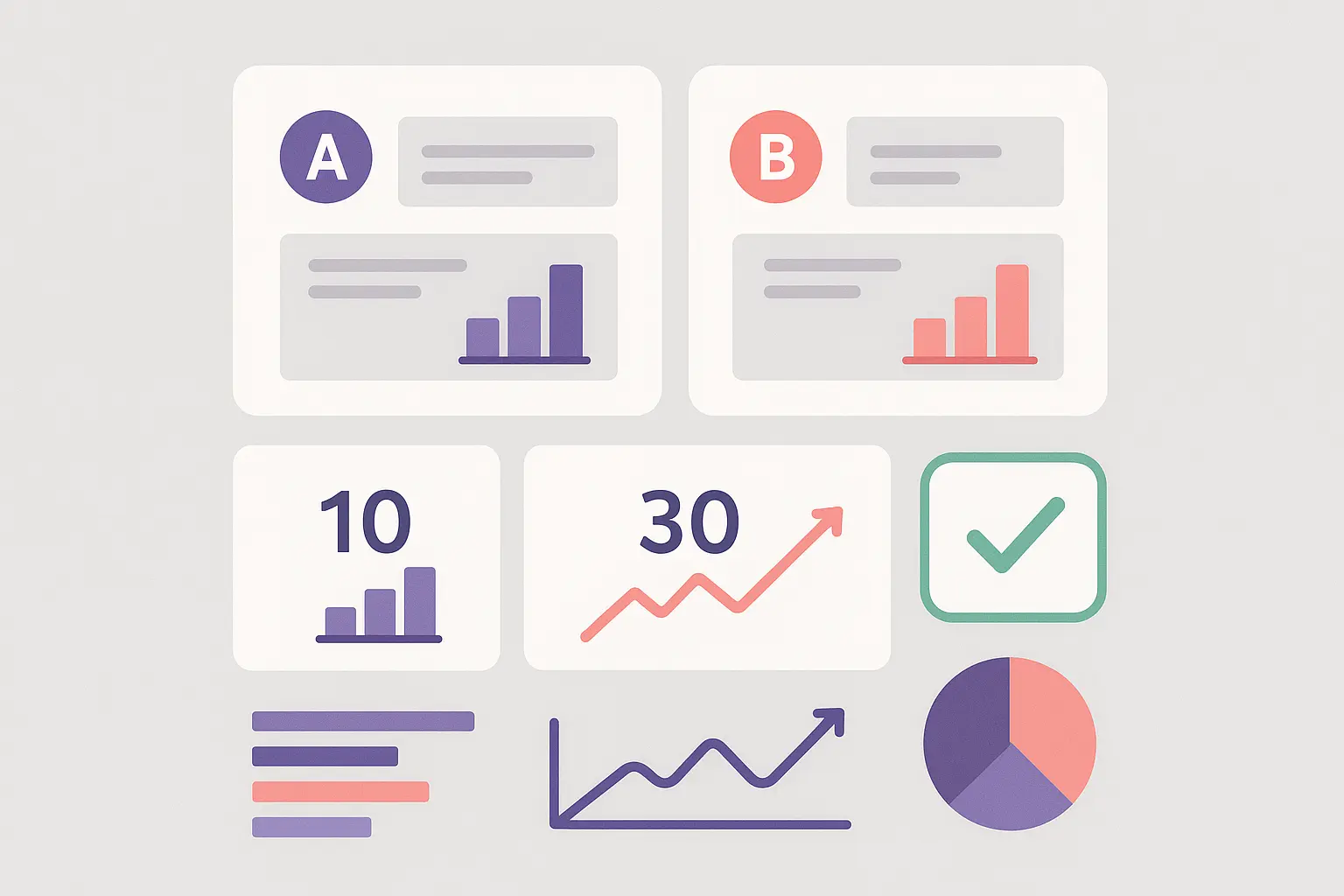
Advanced Tracking That Actually Makes Sense
Most attribution models are way too simplified and completely miss the complexity of how people actually behave online. Customers don’t just search once and buy – they research across multiple devices, compare options over weeks or months, and interact with your brand through various touchpoints before making final decisions.
Advanced tracking helps you understand these messy, complex customer journeys and make much better optimization decisions. But it requires more sophisticated measurement techniques than just looking at basic Google Analytics reports and calling it good.
Cross-Platform Attribution Modeling
Cross-platform attribution modeling addresses one of the biggest challenges in modern marketing measurement: customers use multiple devices and channels throughout their journey, making it incredibly difficult to connect all the touchpoints and accurately attribute conversions to the right sources.
I implement server-side tracking for way more accurate data collection. Client-side tracking (like standard Google Analytics) misses a ton of conversions when users have ad blockers enabled, switch between devices, or clear their cookies regularly. Server-side tracking captures much more complete data by recording events on your server rather than relying entirely on browser-based tracking that can be blocked or lost.
Custom attribution models based on your specific business objectives and actual customer behavior patterns work much better than generic, one-size-fits-all models. If your customers typically research for weeks before purchasing, a time-decay attribution model might give you better insights than last-click attribution. If you’re focused on brand awareness campaigns, first-click attribution might provide more actionable data.
Cohort analysis for long-term customer value measurement groups customers by acquisition date and channel, then tracks their behavior and value over extended time periods. This reveals which channels actually attract customers with higher lifetime values, not just lower upfront acquisition costs.
For an e-commerce client, we built a custom attribution model that weighted touchpoints based on their position in the funnel and how recent they were. The model gave 40% credit to first-touch awareness channels, 35% to mid-funnel research touchpoints, and 25% to final conversion channels. This analysis revealed that while paid search was driving final conversions, organic content and social media were absolutely crucial for initial discovery and consideration. We ended up reallocating 25% of our budget toward upper-funnel activities, which improved overall campaign performance significantly.
Predictive Analytics and Forecasting
Predictive analytics takes all your historical performance data and uses it to forecast future results and optimize resource allocation decisions. This goes way beyond simple trend analysis – it’s about building actual models that can predict performance under different scenarios and market conditions.
I build predictive models for seasonal performance variations that most businesses experience. You probably see predictable patterns throughout the year, but the exact timing and magnitude of these changes can vary. Predictive models help you anticipate these fluctuations and adjust your strategies before you’re caught off guard.
Lifetime value forecasting for different customer segments recognizes that not all customers are equally valuable over time, and different acquisition channels often attract fundamentally different types of customers. Understanding these patterns helps you optimize for long-term business value rather than just short-term conversion metrics.
Scenario planning models for budget allocation decisions help answer important questions like: What happens if you increase your search budget by 50%? What if competitor activity heats up and your costs per click rise significantly? Scenario planning helps you prepare for different market conditions and make more informed strategic decisions before you’re forced into reactive mode.

Industry-Specific Strategies That Work
Generic SEM strategies rarely deliver optimal results because different industries have fundamentally different customer behaviors, sales cycles, and success metrics. What works brilliantly for e-commerce doesn’t work at all for B2B lead generation. What works for local services completely fails for SaaS companies.
Industry-specific case studies provide much more actionable insights because they address the unique challenges and opportunities that exist within specific business contexts rather than trying to be everything to everyone.
E-commerce SEM Strategies
E-commerce search marketing presents some unique opportunities and challenges that you don’t see in other industries. You’re dealing with massive product catalogs, shopping campaigns, dramatic seasonal fluctuations, and complex attribution that spans both online and offline channels.
Product feed optimization becomes absolutely critical for shopping campaign success. Your product titles and descriptions need to be optimized for search relevance while still being compelling enough to make potential customers want to click and buy. This often means finding the right balance between keyword optimization and natural language that actually converts browsers into buyers.
I always set up dynamic remarketing campaigns for abandoned cart recovery because e-commerce customers frequently browse multiple times before actually purchasing. Dynamic remarketing shows them the exact products they viewed previously, often with special incentives or limited-time offers to push them over the conversion line.
Seasonal campaign strategies for peak shopping periods are essential because e-commerce businesses often see dramatic demand fluctuations during holidays and seasonal events. Your entire campaign structure and budget allocation should anticipate these patterns rather than trying to react to them after the fact.
Product category bidding strategies based on profit margins and demand levels make sense because not all products are equally profitable or in equal demand. Your bidding strategies should reflect these differences, investing more aggressively in high-margin products while maintaining visibility for high-demand items that drive overall traffic and brand awareness.
Multi-channel retail integration connects your online marketing efforts with offline sales data, which is crucial for businesses that have both digital and physical presences. I implement store visit tracking for local campaign measurement because many customers research online but actually purchase in physical stores, and you need attribution models that capture this cross-channel behavior.
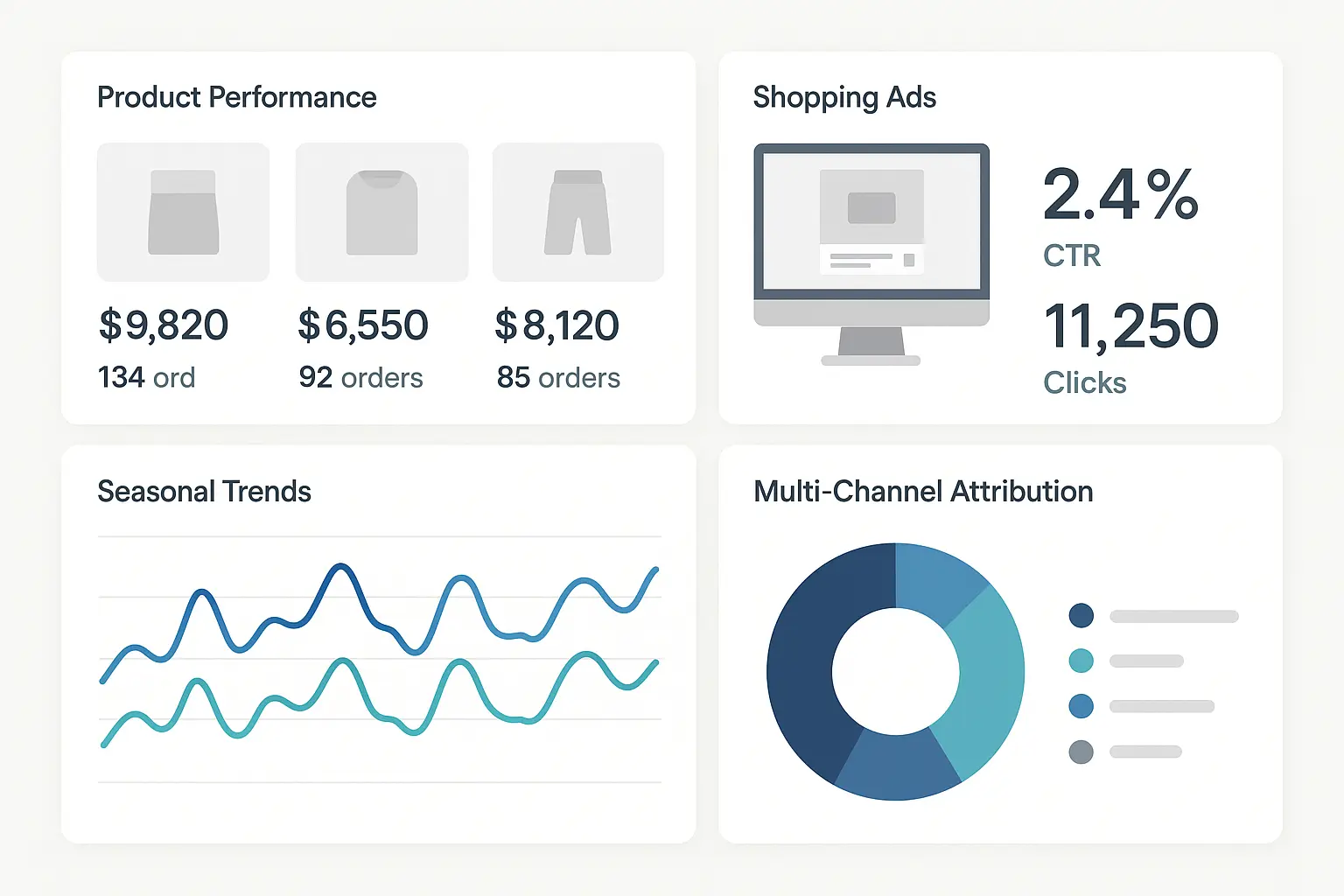
B2B Lead Generation Case Studies
B2B lead generation presents completely different challenges compared to e-commerce. You’re dealing with much longer sales cycles, multiple decision makers who all need to be convinced, higher-value transactions that require more consideration, and complex nurturing processes that can extend for months.
Account-based marketing integration aligns your search marketing efforts with target account strategies that your sales team is already working. I develop custom audiences based on target account lists, which allows you to show different ads and landing pages to prospects from your highest-value target companies.
Personalized landing pages for key accounts and specific industries work because B2B buyers expect relevant, specific information that directly addresses their unique challenges and use cases. Generic landing pages that try to appeal to everyone rarely convert well for high-value B2B prospects who are doing serious research.
Lead scoring integration with CRM systems becomes essential because not all leads are equally valuable in the B2B world, and your marketing qualified lead (MQL) criteria should reflect this reality. I integrate search marketing data directly with CRM systems to track lead quality and eventual sales outcomes over time.
Nurture campaign sequences for different buyer personas address the fact that B2B sales cycles often involve multiple touchpoints spread across weeks or months. Your search marketing should feed prospects into nurture sequences that provide genuine value throughout their research and evaluation process.
Long-term ROI measurement becomes absolutely critical for B2B campaigns because sales cycles can extend for months or even years in complex B2B sales. I implement closed-loop reporting between marketing and sales systems to track which search campaigns ultimately drive actual revenue, not just leads that look good on paper.
Customer lifetime value models for different lead sources help because B2B customers often have much higher lifetime values than B2C customers, but this value might not become apparent immediately. Understanding which channels attract the most valuable long-term customers helps you optimize acquisition strategies for maximum business impact.
Developing Campaigns That Scale
Campaign development that actually scales requires thinking way beyond individual tactics to create integrated systems that work together seamlessly. You need architecture that supports growth without falling apart, processes that maintain quality even as volume increases, and frameworks that can adapt to changing market conditions without requiring complete overhauls.
Campaign Architecture and Planning
Multi-channel campaign integration starts with mapping out the complete customer journey across all possible search touchpoints. How do customers typically discover your brand in the first place? What research process do they follow? Where do they usually convert, and what touchpoints actually influence their final decisions?
I develop unified messaging frameworks that work consistently across organic and paid placements. Your brand voice and core value proposition should be recognizable and consistent whether customers encounter you through organic search results, paid ads, remarketing campaigns, or any other touchpoint.
Cross-channel remarketing sequences nurture prospects through multiple search interactions over time. A typical customer might discover you through organic search, click on a paid ad, visit your website, leave without converting, then see remarketing ads before finally coming back to convert weeks later. Each touchpoint should build strategically on the previous interaction.
Shared KPIs that measure collective campaign impact rather than individual channel-specific metrics give you a much clearer picture of what’s actually working. Revenue attribution, customer lifetime value, and overall market share growth matter way more than individual channel performance metrics that might look good in isolation but don’t drive business results.
Competitive intelligence and market positioning inform all your campaign architecture decisions from the ground up. I conduct comprehensive competitor keyword analysis and ad copy research to understand what strategies are actually working for competitors and where they might be vulnerable to competitive pressure.
Resource allocation and timeline management ensure your campaigns launch successfully and maintain strong performance over extended time periods. I develop dynamic budget allocation models based on performance thresholds that automatically shift resources to your best-performing campaigns without requiring constant manual intervention.
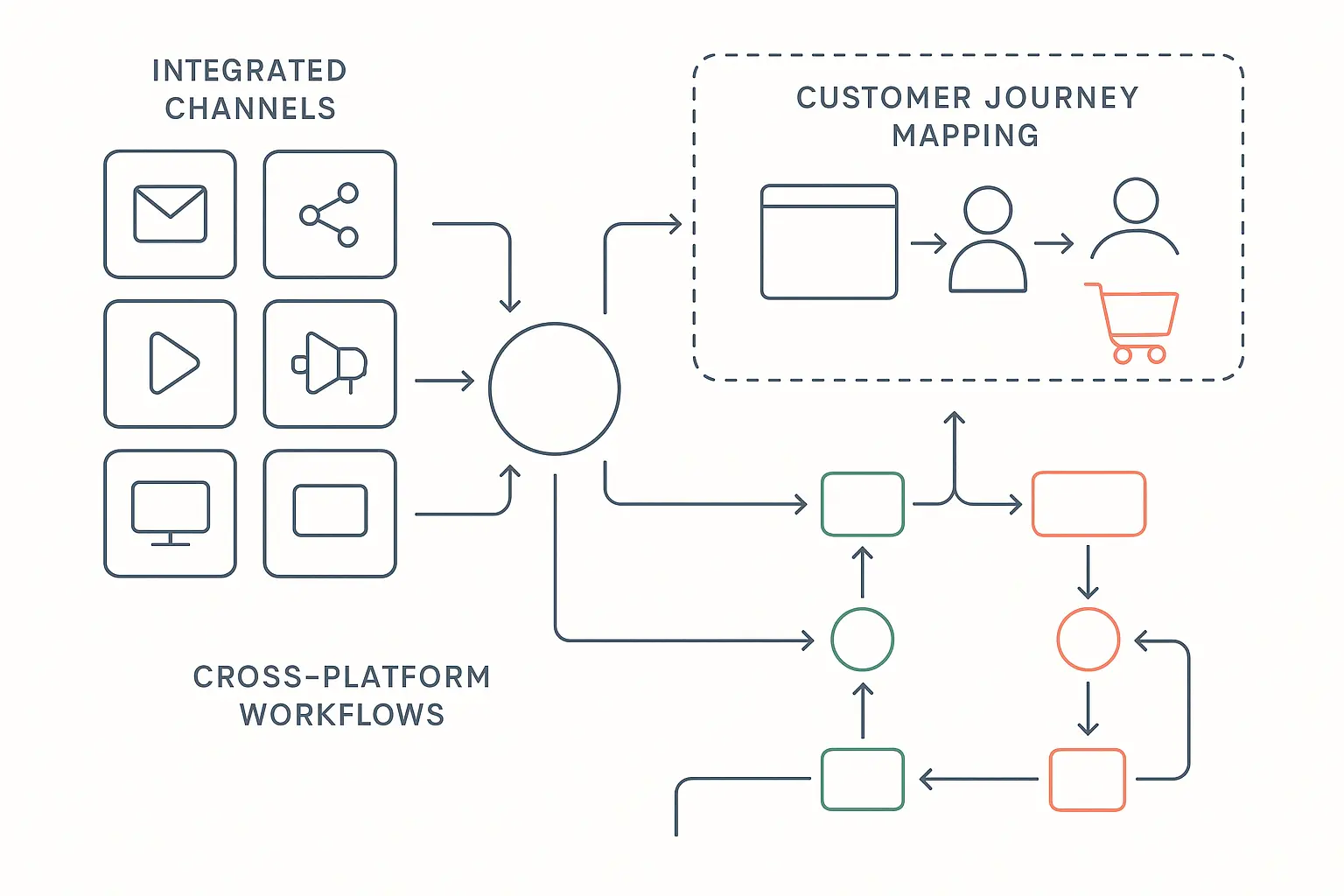
Campaign Execution and Quality Control
Quality assurance protocols prevent costly mistakes and ensure consistent performance across all your campaigns as they scale up. I implement comprehensive pre-launch checklists for technical setup verification – are tracking codes installed correctly? Are landing pages properly optimized for mobile devices? Are ad groups structured in ways that make sense for both performance and management?
Ongoing monitoring protocols for ad quality scores and organic ranking stability matter because quality scores directly affect your cost per click and ad positioning. Ranking fluctuations can indicate technical issues or algorithm changes that require immediate attention before they tank your performance.
Performance threshold alerts that trigger immediate optimization actions help you catch problems when conversion rates drop below acceptable levels, when costs exceed target thresholds, or when traffic patterns change significantly. You need to know about these issues immediately, not when you check your dashboard next week.
Stakeholder communication and reporting maintain alignment throughout campaign execution across all team members and decision makers. I develop automated reporting dashboards that provide real-time performance visibility to all stakeholders, but different audiences need different levels of detail – executives want high-level business impact metrics, while campaign managers need granular performance data they can actually act on.
Regular review cycles for strategy adjustments and optimization opportunities include weekly tactical reviews that focus on immediate optimization opportunities, monthly strategic reviews that assess overall campaign direction and resource allocation, and quarterly business reviews that evaluate how campaigns are contributing to broader business objectives.
Final Thoughts
Building effective search engine marketing case studies requires way more than just documenting results after the fact – it demands a systematic approach to measurement, optimization, and strategic thinking that starts from day one. The frameworks I’ve outlined here represent years of testing, refinement, and real-world application across different industries and business models that actually work in practice.
The most successful SEM campaigns integrate multiple channels seamlessly, leverage advanced attribution modeling to understand complex customer journeys, and maintain laser focus on business impact rather than vanity metrics that look impressive but don’t drive revenue. Whether you’re optimizing for e-commerce sales, B2B lead generation, or local service bookings, the core principles remain consistent: establish clear baselines, document your strategic decisions thoroughly, measure everything comprehensively, and optimize continuously based on what the data actually tells you.
Remember that case studies serve two crucial purposes – they demonstrate past success to clients or stakeholders, and they inform future strategy decisions for you and your team. The best case studies provide actionable insights that others can adapt and implement for their own situations, not just impressive-looking charts and graphs that make you look smart but don’t actually help anyone.
Focus on documenting the thinking behind your decisions, the challenges you encountered along the way, and the lessons you learned from both successes and failures. The mistakes and pivots are often more valuable than the wins because they show what doesn’t work and why.
The search landscape keeps evolving at breakneck speed, competition keeps getting more intense, and customer behavior keeps changing in unpredictable ways. But if you build solid measurement frameworks, document your processes thoroughly, and stay laser-focused on driving real business results rather than just improving metrics that look good in reports, you’ll create case studies that actually matter – both for proving your past success and planning your next strategic moves.
Most importantly, don’t let perfect be the enemy of good when it comes to documentation. Start capturing what you can now, even if your systems aren’t perfect yet. The insights you gain from thorough documentation will compound over time and make every future campaign more effective than the last.
